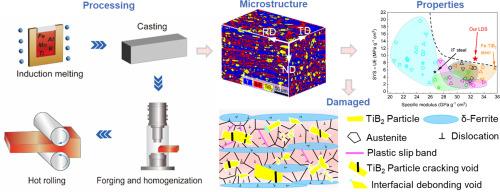低密度高模量钢由过共晶TiB2和高Al铁素体相组成
IF 14.3
1区 材料科学
Q1 MATERIALS SCIENCE, MULTIDISCIPLINARY
引用次数: 0
摘要
高铝低密度钢由于其轻量化和节能应用的潜力而受到广泛的研究。然而,高铝含量会导致严重的问题,例如杨氏模量的显著降低,以及铸造和加工中碳化物引起的挑战。这项研究旨在通过推进轻量化钢的概念来解决这些问题,提供一种新型的无碳、奥氏体基低密度三相钢。这种新颖的方法使陶瓷和δ铁氧体的利用达到了物理性能(低密度和高杨氏模量)和力学性能的最佳平衡。具体来说,使用传统的经济有效的钢制造路线,我们生产了热轧时的非均匀组织,其特征是完全等轴奥氏体基体嵌入了细长的δ-铁素体带和微米尺寸的TiB2颗粒。物理上,这种新型低密度钢达到了令人印象深刻的6.88 g cm−3的低密度,同时保持了225 GPa的高杨氏模量,从而获得了高比模量。机械方面,与传统的Fe-TiB2钢相比,这种新钢的屈服强度提高了近100%,同时保持了良好的延展性。增强的强度-塑性平衡归因于δ铁素体及其相关的微观组织非均质性的双重作用:δ铁素体中的高位错密度通过复合效应增强了钢,δ铁素体和奥氏体之间的软/硬相对比通过产生几何上必要的位错促进了额外的应变硬化。这项工作提出了一种可行的方法,可以大规模生产低密度、硬度、强度和韧性的钢,以实现成本效益低的轻量化应用。本文章由计算机程序翻译,如有差异,请以英文原文为准。

Low-density and high-modulus steel achieved by hypereutectic TiB2 and high Al ferrite phase
High-aluminum low-density steels have been extensively studied due to their potential for lightweight and energy-saving applications. However, high aluminum content causes severe problems, such as a marked reduction in Young’s modulus and also carbide-induced challenges in casting and processing. This study aims to tackle these issues by advancing the concept of lightweight steels, offering a new class of carbon-free, austenite-based low-density triplex steel. This novel approach enables the utilization of ceramic and δ-ferrite to achieve an optimal balance of physical properties (low density and high Young’s modulus) and mechanical properties. Specifically, using conventional cost-effective steel fabrication routes, we produced an as-hot-rolled heterogeneous microstructure characterized by a fully equiaxed-austenitic matrix embedded with elongated δ-ferrite bands and micron-sized TiB2 particles. Physically, this new low-density steel achieves an impressively low density of 6.88 g cm−3 while preserving a high Young’s modulus of 225 GPa, resulting in a high specific modulus. Mechanically, this new steel shows nearly a 100% increase in yield strength compared to the conventional Fe-TiB2 steel, while retaining good ductility. The improved strength-ductility balance is attributed to the dual roles of δ-ferrite and its associated microstructural heterogeneity: the high dislocation density in δ-ferrite strengthens the steel through the composite effect, and the soft/hard phase contrast between δ-ferrite and austenite promotes additional strain hardening via the generation of geometrically necessary dislocations. This work presents a viable approach to producing low-density, stiff, strong, and ductile steels on a large scale for cost-effective lightweight applications.
求助全文
通过发布文献求助,成功后即可免费获取论文全文。
去求助
来源期刊

Journal of Materials Science & Technology
工程技术-材料科学:综合
CiteScore
20.00
自引率
11.00%
发文量
995
审稿时长
13 days
期刊介绍:
Journal of Materials Science & Technology strives to promote global collaboration in the field of materials science and technology. It primarily publishes original research papers, invited review articles, letters, research notes, and summaries of scientific achievements. The journal covers a wide range of materials science and technology topics, including metallic materials, inorganic nonmetallic materials, and composite materials.
 求助内容:
求助内容: 应助结果提醒方式:
应助结果提醒方式:


